High Priority Weeds
Council recognises that early detection of priority weeds is the most cost-effective way to manage weeds. With your help, we are targeting six Priority weeds that have the ability to significantly impact our bushlands and community.
Should you spot any of the weeds below in public lands, please contact Council.
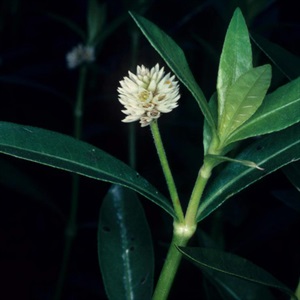
- Must not be imported into NSW or sold
- Must be continuously suppressed where practical
- Notify Council of any new infestations of this priority weed
Impact: Alligator weed is a potentially devastating weed that grows in water and on land, affecting both waterways and floodplain areas.
What does it look like?
Alligator weed is a summer growing perennial herb, generally appearing from November to March.
- It has small white papery flower heads 8–10 mm in diameter. The flowers grow at the end of short stalks which rise from the leaf axils.
- The leaves occur in opposite pairs along the stems. They are shiny, spear-shaped, sessile (no stalk), entire and about 2–7 cm long and 1–2 cm wide.
- The plant forms dense mats of interwoven creeping and layering stems. Over water, stems grow to 60 cm high and up to 10 m long and have large, hollow internodes. Mats may extend 15 m over the water surface and become so robust they can support the weight of a person. On land, stems are shorter and internodes are smaller and less hollow.

Alligator weed is generally distinguished from other plants by its combination of the following three features:
- small white papery flowers on short stalks
- leaves in opposite pairs
- hollow stems
For detailed information, visit NSW WeedWise.
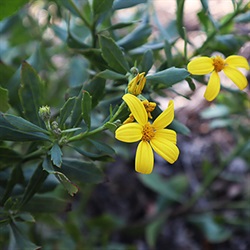 Boneseed
Boneseed
- Must not be imported into NSW or sold
- 'Control Order' which means that everyone in the state must work together to prevent the spread of Boneseed.
- Notify Council immediately of any new infestations
Impact: Boneseed is an erect, perennial shrub that has the ability to aggressively invade native bushland in Australia. Its vigorous growth and ability to regenerate and spread quickly in disturbed situations, such as fire or clearing, allows it to outcompete native species. It is also a threat to a number of significant rare or threatened species.
What does it look like?
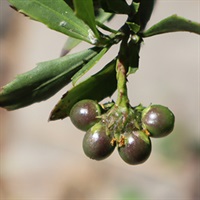 Its yellow flowers have 5-8 petals that are up to 3 cm in diameter. Peak flowering occurs from August to October. Some plants flower in the first year, although most are at least 18 months old.
Its yellow flowers have 5-8 petals that are up to 3 cm in diameter. Peak flowering occurs from August to October. Some plants flower in the first year, although most are at least 18 months old.-
Young fruit are round, green and fleshy and turn black when mature. They contain a single, smooth, round seed (6-7 mm diameter) which is bone-coloured when dry, giving rise to the name ‘boneseed’.
- Woody stems are branched and upright.
- Leaves are 3-9 cm long and alternate along the stems. They are oval shaped with irregularly serrated edges. New growth is covered with white hairs that are shed as the leaves mature.
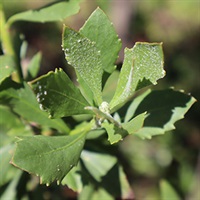 For detailed information, visit NSW WeedWise.
For detailed information, visit NSW WeedWise.
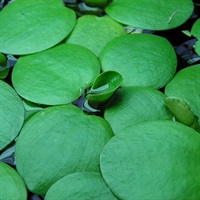 Frogbit
Frogbit
- Prohibited matter - must not be imported or sold in the whole state of NSW.
- Report any sightings of this weed immediately to Council
Impact: Frogbit is a floating aquatic weed that can very quickly develop into mats of runners, and invade and smoother waterways. It is often kept and traded for use in fish ponds, aquariums and water features.
What does it look like?
- Plants float on the water surface, and have smooth, rounded, fleshy green leaves up to 4 cm across, with sponge-like sections on their undersides.
Check for plants in fish ponds, aquariums, fish tanks, water features, dams and waterways.
For detailed information, visit NSW WeedWise.
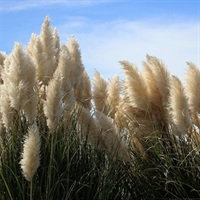 Pampas Grass
Pampas Grass
Impact: Pampas grass competes with native vegetation and is a fire hazard.
What does it look like?
Pampas grass grows in clumps about 1 - 1.5 m across, with fluffy flower heads on tall stems. When in flower, common pampas grass grow up to 6 m tall and pink pampas grass grow up to 4 m tall.
Flower heads are:
- Common pampas grass are white, pink or mauve, and are present from mid-March to late May.
- Pink pampas are pink when young, fading to dark brown, and are present from January to late March.
Leaves are:
- finely serrated on the edges
- upright and arched if it is common pampas
- arching with leaf tips touching the ground if it is pink pampas
- with a leaf sheath that is:
-
- without a line up the middle (midrib)
- smooth or slightly hairy if it is common pampas
- very hairy if it is pink pampas
For detailed information, visit NSW WeedWise.
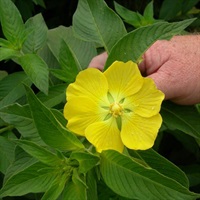
Primrose Willow
Impact: This fast-growing shrub thrives in moist, wetland environments with the potential to choke waterways and dominate all aquatic vegetation within a short timeframe. Its dense stands can interfere with the natural flow of the waterway. The thick canopy reduces the amount of light entering the water and decreases water temperature. This ultimately affects the native aquatic flora and fauna communities.
What does it look like?
The Primrose Willow, also known as Ludwigia, is a perennial shrub growing up to 3 m high.
- Stem is hairy when young, dark green to brownish green in colour branched.
- Its leaves are are oval-shaped with pointed tip and are arranged alternately along the stem. They are 5-10 cm long and 1-3 cm wide, hairy with prominent veins.
- A single yellow flower, that is 2-4 cm across, grows in the fork of upper leaves. It usually has 4 petals that are 1-3 cm long and 1-3 cm wide with 4 pale green leaf-like structures below petals. A flower lasts for only one day.
- The fruit is a reddish-brown capsule that is 10-25 mm long and 6-10 mm wide. Each capsule contains thousands of seeds that are light brown in colour and 0.6–0.8 mm long. Its reddish sepals remain attached.
For detailed information, visit NSW WeedWise.
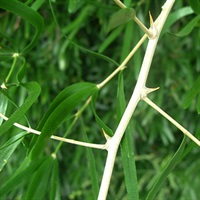 Sicklethorn Asparagus
Sicklethorn Asparagus
- Not to be sold in NSW
- Plant must be eradicated from the land
- Notify Council of any new infestations
Impact: Sicklethorn is a robust climber that can smoother native plants up to 6 m tall. It is an emerging environmental weed with potential to invade a wide range of coastal habitats and can expand into very large and continuous infestations.
What does it look like?
- Stems originate from a basal crown that may be to more than 30 cm in diameter. Stems become woody with age and have sharp, stout thorns that curve backwards.
- Leaf-like cladodes (modified stems) are produced in clusters of 3-6 at the nodes. They are shiny, dark green, straight or slightly sickle shaped (hence the common name), hairless, elongate, 30-90 mm long, 3-5 mm wide and present year-round.
- Flowers are small, bisexual (both male and female parts present), white, borne on short stalks in slightly elongated clusters in the axils of the cladodes. Flowers occur from spring to early summer.
- Berries are 1-3-seeded, 7-10 mm in diameter, green at first and bright red at maturity. Fruit are borne all year round.
- Has a root system has short rhizomes and forms swollen tubers.
For detailed information, visit NSW WeedWise.